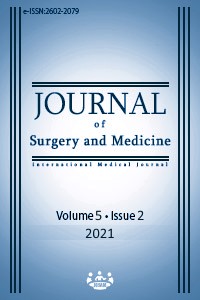Arthroereisis of the subtalar joint in the management of pediatric flexible flatfoot: A retrospective clinical study
Keywords:
Arthroereisis, Flatfoot, Gastrocnemius lengthening, Pediatric, Subtalar jointAbstract
Background/Aim: Management of flatfoot is still a challenge for orthopedic surgeons because it is a common and physiological process that usually requires observation and follow-up due to its asymptomatic nature in the pediatric population. The aim of this study was to investigate the radiological and pedobarographic results of symptomatic flexible flatfoot in pediatric patients who were treated by simultaneous gastrocnemius lengthening and arthroereisis of the subtalar joint. Methods: This retrospective cohort study included 20 feet of 10 children (5 males, 5 females; mean age: 11.4 years; age range 9-14 years) who underwent simultaneous gastrocnemius lengthening and subtalar joint arthroereisis procedure for bilateral symptomatic flatfoot. The mean follow-up period was 24 months (range 11-32). All arthroereisis procedures were performed using a cannulated arthroereisis titanium implant. To assess the radiological results, calcaneal pitch angle and Meary’s talus-first metatarsal angle on radiographs were measured preoperatively and at the final follow-up. Pedobarographic assessment was based on plantar heel and forefoot pressures preoperatively and at the final follow-up. Results: The mean calcaneal pitch angle increased from 8° (0.93°) preoperatively to 16.5° (1.14°) postoperatively (p<0.001), while the mean Meary’s talus-first metatarsal angle decreased from 7.5° (1.14°) preoperatively to 0.5° (0.51)° postoperatively (p<0.001). The mean heel peak pressure and forefoot peak pressure increased from 11.5 (1.14) N/cm2 and 10.5 (1.14) N/cm2 preoperatively to 17.5 (1.14) N/cm2 and 15.5 (1.14) N/cm2 postoperatively, respectively (p<0.001 for both variables). In addition, the pedobarographic assessment revealed that medially increased center of pressure moved to laterally increased center of pressure in all feet with an improvement in terms of forefoot and heel pressures. None of the patients experienced major intraoperative or postoperative complications. Conclusion: Simultaneous gastrocnemius lengthening and arthroereisis of the subtalar joint seems an effective and safe surgical option for symptomatic flexible flatfoot in pediatric patients.
Downloads
References
Caravaggi P, Lullini G, Berti L, Giannini S, Leardini A. Functional evaluation of bilateral subtalar arthroereisis for the correction of flexible flatfoot in children: 1-year follow-up. Gait Posture. 2018 Jul;64:152-8.
Herring JA. Tachdjian's Pediatric Orthopaedics. 5th Edn. Elsevier, Philadelphia 2013.
Roth S, Sestan B, Tudor A, Ostojic Z, Sasso A, Durbesic A. Minimal invasive calcaneo-stop method for idiopathic flexible per planovalgus in children. Foot Ankle Int. 2007;28(9):991-5.
Mosca VS. Flexible flatfoot in children and adolescents. J Child Orthop. 2010 Apr;4(2):107-21.
Faldini C, Mazzotti A, Panciera A, Perna F, Stefanini N, Giannini S. Bioabsorbable implants for subtalar arthroereisis in pediatric flatfoot. Musculoskelet Surg. 2018 Apr;102(1):11-9.
Viladot Voegeli A, Fontecilla Cornejo N, Serrá Sandoval JA, Alvarez Goenaga F, Viladot Pericé R. Results of subtalar arthroereisis for posterior tibial tendon dysfunction stage IIA1. Based on 35 patients. Foot Ankle Surg. 2018 Feb;24(1):28-33.
Arangio GA, Salathe EP. A biomechanical analysis of posterior tibial tendon dysfunction, medial displacement calcaneal osteotomy and flexor digitorum longus transfer in adult acquired flat foot. Clin Biomech (Bristol, Avon). 2009 May;24(4):385-90.
Fernández de Retana P, Alvarez F, Viladot R. Subtalar arthroereisis in pediatric flatfoot reconstruction. Foot Ankle Clin. 2010 Jun;15(2):323-35.
Schon LC. Subtalar arthroereisis: a new exploration of an old concept. Foot Ankle Clin. 2007 Jun;12(2):329-39.
Wong DW, Wang Y, Chen TL, Leung AK, Zhang M. Biomechanical consequences of subtalar joint arthroereisis in treating posterior tibial tendon dysfunction: a theoretical analysis using finite element analysis. Comput Methods Biomech Biomed Engin. 2017 Nov;20(14):1525-32.
Hagen L, Pape JP, Kostakev M, Peterlein CD. Pedobarographic changes during first month after subtalar extra-articular screw arthroereisis (SESA) operation of juvenile flexible flatfoot. Arch Orthop Trauma Surg. 2019 Jul;140:313-20.
Jerosch J, Schunck J, Abdel-Aziz H. The stop screw technique-a simple and reliable method in treating flexible flatfoot in children. Foot Ankle Surg. 2009;15(4):174-8.
Sullivan JA. Pediatric flatfoot: evaluation and management. J Am Acad Orthop Surg. 1999 Jan;7(1):44-53.
Lin CJ, Lai KA, Kuan TS, Chou YL. Correlating factors and clinical significance of flexible flatfoot in preschool children. J Pediatr Orthop. 2001 May-Jun;21(3):378-82.
Ledoux WR, Hillstrom HJ. The distributed plantar vertical force of neutrally aligned and pes planus feet. Gait Posture. 2010;15:1-9.
Dziuba A, Szpala A. Foot kinematics in gait of children with cerebral palsy (CP). Acta Bioeng Biomech. 2008;10(4):3-6.
Alvarez C, De Vera M, Chhina H, Black A. Normative data for the dynamic pedobarographic profiles of children. Gait Posture. 2008 Aug;28(2):309-15.
Liu XC, Thometz JG, Tassone C, Barker B, Lyon R. Dynamic plantar pressure measurement for the normal subject: Free-mapping model for the analysis of pediatric foot deformities. J Pediatr Orthop. 2005 Jan-Feb;25(1):103-6.
Ford SE, Scannell BP. Pediatric Flatfoot: Pearls and Pitfalls. Foot Ankle Clin. 2017 Sep;22(3):643-56.
Matheis EA, Spratley EM, Hayes CW, Adelaar RS, Wayne JS. Plantar measurements to determine success of surgical correction of Stage IIb adult acquired flatfoot deformity. J Foot Ankle Surg. 2014 Sep-Oct;53(5):562-6.
MacMahon A, Hillstrom HJ, Do HT, Chan JY, Deland JT, Ellis SJ. In Vivo Plantar Pressures in Adult-Acquired Flatfoot Compared to Control Using an Intraoperative Pedobarographic Device. HSS J. 2017 Jul;13(2):136-45.
Ortiz CA, Wagner E, Wagner P. Arthroereisis: What Have We Learned? Foot Ankle Clin. 2018 Sep;23(3):415-34.
Saxena A, Via AG, Maffulli N, Chiu H. Subtalar Arthroereisis Implant Removal in Adults: A Prospective Study of 100 Patients. J Foot Ankle Surg. 2016 May-Jun;55(3):500-3.
Downloads
- 620 641
Published
Issue
Section
How to Cite
License
Copyright (c) 2021 Çağrı Neyişci, Yusuf Erdem, Ahmet Bilekli
This work is licensed under a Creative Commons Attribution-NonCommercial-NoDerivatives 4.0 International License.
















